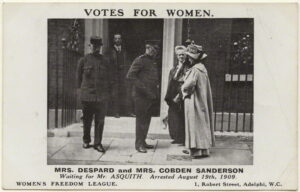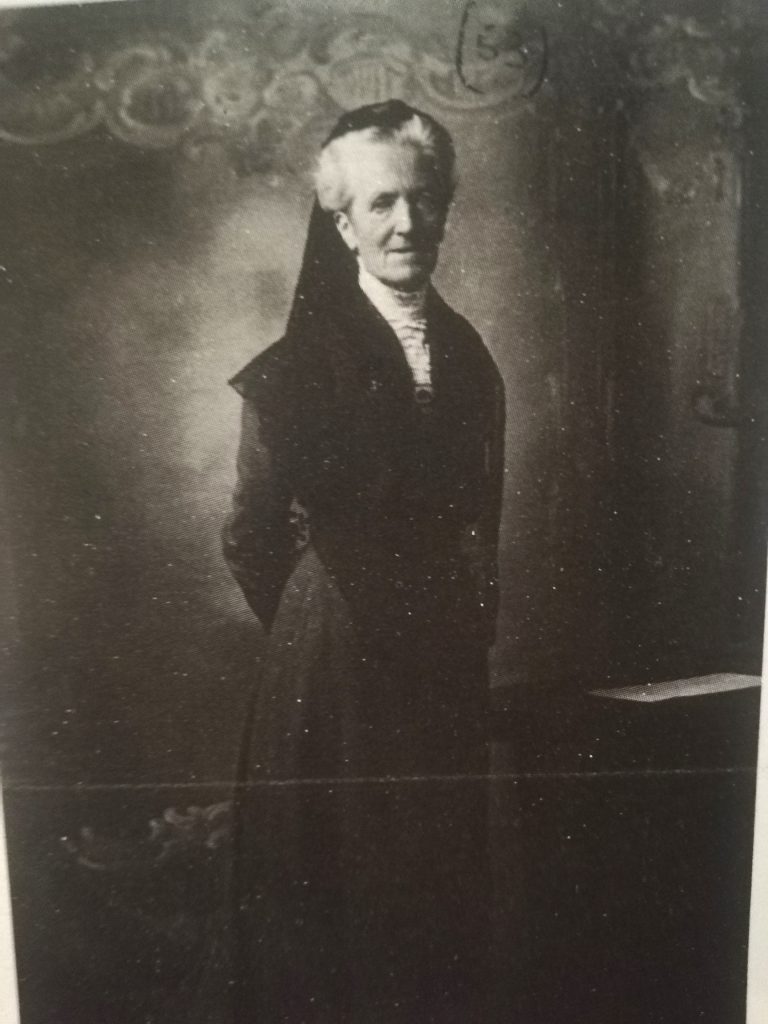
the rediscovered suffragette
Emmeline Pankhurst with daughters Sylvia, Christabel, Adela? Time magazine once named the suffragette leader one of the hundred most important people of the 20th century. Millicent Fawcett? Not as well known, but yes, of course – the one who led the law-abiding branch of the same movement.
And Charlotte Despard? Although famous among reformers of her time, not least as the founder of the most long-lived of the British women’s suffrage organisations, this fighter has largely fallen out of history. Perhaps the omission has to do with the fact that Charlotte Despard declared herself to be a socialist, and that the suffragette movement, despite the different demands of the overall women’s movement, is often portrayed as a bourgeois matter?
Or, on the contrary, that as a defected Victorian lady, she cannot be imagined as a suffragette? Maybe prejudice about age comes into play? The fact that Despard was well over forty when she started her activist career and nearly seventy when she formed the Women’s Freedom League (WFL) to promote the situation of female workers as crucial arguments for women’s suffrage?
Whatever the reason: highlighting Charlotte Despard is not only valuable in itself, but it also makes the image of the women’s suffrage movement more whole. Margaret Mulvihill’s Charlotte Despard, A Biography (London: Pandora 1989) and recently Lynne Graham-Matheson and Helen Matheson-Pollock’s Mrs Despard and the Suffrage Movement (Yorkshire: Pen & Sword History 2020) contribute to this.
The latter, in particular, follows Despard’s activism – which began at a time when a woman of her social class and age was expected to wait for the end of life in a corner of a private garden. All in contrast to old men who could look forward to increased activity and more powers in public life. One line of hers shows how she tackled the question: ‘When I was twenty, I was older than I am today.’ Uttered, by the way, long before Bob Dylan and Back pages’ ‘I’m younger than that now’ – and the author Dorothy Carnegie’s ‘Don’t grow old – grow up!’
At just over 40, Charlotte Despard’s husband died, and she was widowed. By law a woman of majority, she dressed in long veils and sandals – eventually her hallmark – and moved from a large house of servants to the poor quarter of Nine Elms in Battersea, London. Here, she used her husband’s capital to serve nutritious vegetable food, offering reading events and other activities to single mothers and their children, meaning most people in the area.

In Battersea, an urban counterculture arose; labour rights, women’s rights, poor care, prisoners’ rights; animal rights, vegetarianism; the independence of India and Ireland respectively; Charlotte Despard was elected to sit on many committees and became a valued speaker who used poetry to reach the audience. At one point, she was knocked over and hit in the head by a rock from an anti-voting mob – however, this did not stop her from entering the stage. In Margaret Mulvihill’s biography, she is photographed as a passionate eighty-nine-year-old speaker at a major anti-fascist rally in Trafalgar Square in 1933.
Like many women’s rights campaigners, Charlotte Despard engaged in writing as well. The bibliography includes nine novels and a number of titles of non-fiction, including a 1913 title on women’s economic conditions. Statistics showed that the majority – seventy-two per cent – of the poorest consisted of women and children, who were not infrequently industrial workers. Labour struggle was therefore a struggle for women, and the revolution in the form of a flurry of gradual reforms, must be about overturning patriarchy. One way was to employ the ballot box. In 1918, when women became eligible for Parliament, Charlotte Despard stood for the Independent Labour Party in a campaign led by John Archer, neighbour of hers in Battersea, the first black mayor in London and one of the first in Great Britain.

After the country’s government had ignored the demands of the suffrage movement in 1912, and several suffragettes had died as a result of police violence on the streets and force-feeding in prison, a faction began to resort to guerrilla methods: fires, sabotage, and destruction of state and private property. The Women’s Freedom League, largely the work of Charlotte Despard, and formed in 1907, offered alternatives to the path taken: civil disobedience in the aftermath of Hortensia in ancient Rome, Thoreau, and later Gandhi, who in turn was inspired by the suffragette movement.
In addition to female workers, the WFL gathered the movement’s vegetarians, artists, writers, non-heterosexuals; encouraged creativity in the fight and, as an organisation, distanced itself from violence. The association organised tax resistance, actions of civil disobedience in Parliament, hikes, and tours across the country and – perhaps most worth noting – boycotting of the 1911 census. More than 10,000 people left home and work and gathered in public places in protest of the misogynistic laws.
Unlike Pankhurst and Fawcett, during World War I, the WFL and Charlotte Despard continued to work for the equal suffrage of all women. She advocated pacifism and welfare policy and founded several peace organizations in defiance of public opinion and the government’s line.
In 1918, women over the age of 30 received the right to vote, given that they owned or rented a house or had a university degree,. Ten years later, in 1928, equal voting rights were introduced for most groups of men and women over the age of 21. Residents in the female category in the empire overseas were still left out of the suffrage reform. In India, women were only given the right to vote when the country gained independence from The United Kingdom (1947). Charlotte Despard’s WFL was then the only remaining voting association. The organization lasted until 1961.
When the Soviet Union was debated in England in 1930, Charlotte Despard and a number of sympathizers went there to make an assessment of their own. To be presented with realized ideals seems to have been overwhelming – in any case, the group did not manage to detect any problems. In their eventual defence, one may say that they did not know what we know today about the use of fraudulent propaganda.
Charlotte Despard belonged to a radical political direction on a spiritual basis in opposition to all forms of cruelty and injustice to man and animal. As a Catholic, Republican, vegetarian, suffragette, pacifist, socialist, and anti-fascist, she made many friends during her 50-year career – but also enemies. It would be strange and sad if this fact – she died abandoned and without resources – would lead to her work and methods of struggle being forgotten. Charlotte Despard has a place in public education next to Pankhurst and Fawcett – and along with the many who gave their all for a better society.
- Charlotte Despard: A Biography by Margaret Mulvihill, London: Pandora, 1989
- Mrs Despard and the Suffrage Movement by Helen Matheson-Pollock and Lynne Graham-Matheson: Yorkshire: Pen & Sword Books, 2020
- Earlier book: An Unhusbanded Life, Charlotte Despard, Suffragette, Socialist, and Sinn Féiner by Andro Linklater, London: Hutchinson, 1980
- Time Magazine, article by Marina Warner, June 14th 1999.
Published in Swedish in Syre 10 September 2021
Photographs:
- Charlotte Despard and Mrs Cobden-Sanderson arrested waiting to hand over a petition to Mr Asquith at 10 Downing Str., London. Unknown photographer, halftone postcard print, August 19th 1909, Public Domain
- Charlotte Despard as President of the Women’s Freedom League, portrait by Mary Evans/Fawcett Library; illustration no 5 in Margaret Mulvihill’s biography
- Mayor John Archer, November 10th 1913, Public Domain
© Arimneste Anima Museum # 18